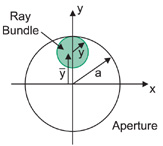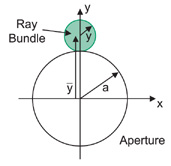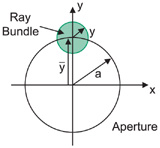Optipedia • SPIE Press books opened for your reference.
Vignetting
Excerpt from Field Guide to Geometrical Optics
While the stop alone defines the axial ray bundle, vignetting occurs when other apertures in the system, such as a lens clear aperture, block all or part of an off-axis ray bundle.
No vignetting occurs when all of the apertures pass the entire ray bundle from the object point. Each aperture radius a mustequal or exceed the maximum height of the ray bundle at the aperture.

Unvignetted:

The maximum FOV supported by the system occurs when an aperture completely blocks the ray bundle from the object point.
Fully vignetted:


The second vignetting condition ensures that the aperture passes the marginal ray and is not the system stop. By definition, vignetting cannot occur at the aperture stop or at a pupil.
A third vignetting condition is defined when an aperture passes about half of the ray bundle from an object point.

Half vignetted:

The vignetting conditions are used in two different manners:
For a given set of apertures, the FOV that the system will support with a prescribed amount of vignetting can be determined. A different chief ray defines each FOV.
For a given FOV and vignetting condition, the required aperture diameters can be determined.
A system with vignetting will have an image that has full irradiance or brightness out to a radius corresponding to the unvignetted FOV limit. The irradiance will then begin to fall off, going to about half at the half-vignetted FOV, and decreasing to zero at the fully vignetted FOV. This fully vignetted FOV is the absolute maximum possible. This discussion ignores the obliquity factors of radiative transfer, such as the cosine fourth law.
The diameter of the aperture stop is very important design parameter for an optical system as it controls five separate performance aspects of the system:
|
J. E. Greivenkamp, Field Guide to Geometrical Optics, SPIE Press, Bellingham, WA (2004).
View SPIE terms of use.

